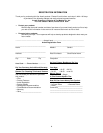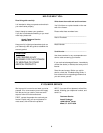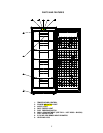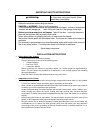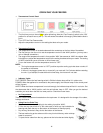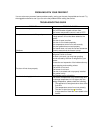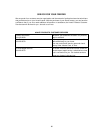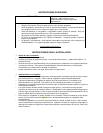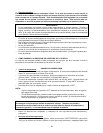
12
? Freezing Fresh Foods
? Proper use of the appliance, adequately packed food, correct temperature and taking into account
hygienic precautions will substantially influence the quality of freezing the food or storing of the
frozen foods.
? This compartment is designed for the long-term storage of frozen food.
? The storage life of frozen foods varies and the recommended storage time should not be exceeded.
? Pre-packed commercially frozen food should be stored in accordance with the frozen foods
manufacturer’s instructions for a three star frozen food storage compartment or home freezer.
? Place frozen food into the freezer as quickly as possible after purchase. If there are instructions on
the packet, carefully follow these instructions regarding storage times.
? Carefully select food you intend to freeze, it should be of adequate quality and suitable for freezing.
? Use correct packaging and wrap it tight.
? The packaging should be airtight and shouldn’t leak since this could cause substantial vitamin loss
and dehydration of foods.
? Foils and bags should be soft enough to tightly wrap around the foods.
? When preparing foods to be frozen, consider sanitary precautions.
? Mark packages with following data: kind and amount of foods and the date of loading.
? It is most important that the food is frozen as quickly as possible.
? If the loading amount is too large, the quality of freezing is reduced which affects the quality of
frozen foods.
CARE AND MAINTENANCE
? Cleaning Your Freezer
? Upon installation of your new appliance, it is recommended that it be cleaned thoroughly.
? Turn the temperature control to "OFF", unplug the freezer, remove the food and storage drawers.
? Wash the inside with a damp warm cloth containing a water and baking soda solution. The solution
should be about 2 tablespoons of baking soda to a quart of water.
? Wash the storage drawers with a mild detergent solution.
? Be sure to keep the door gasket (seal) clean to keep the unit running efficiently.
? The outside of the freezer should be cleaned with mild detergent and warm water.
? Dry the interior and exterior with a soft cloth.
? The condenser coils should be vacuumed when they are dusty or dirty.
? It is recommended that the unit be cleaned each time it is defrosted to help keep the unit odor free
and running efficiently.
CAUTION
Failure to unplug the freezer could result in electrical shock or personal injury.
? Defrosting Your Freezer
? When? For the most efficient operation and minimum energy consumption, defrost the freezer
when the frost on the freezer walls is excessive or ¼ to ½ inch thick.
? Choose a time when the stock of frozen food is low.
CAUTION
Do not use boiling water because it may damage the plastic parts. In addition, never use a sharp
or metallic instrument to remove frost as it may damage the cooling coils and will void the
warranty. We recommend using the plastic scraper provided with your unit.
? Turn the thermostat knob to “OFF”. The power supply light should be off (green light out).
? Remove the frozen food from the freezer and place it in a cooler to protect the food.
? Remove the drawers.
? Unplug the freezer.



